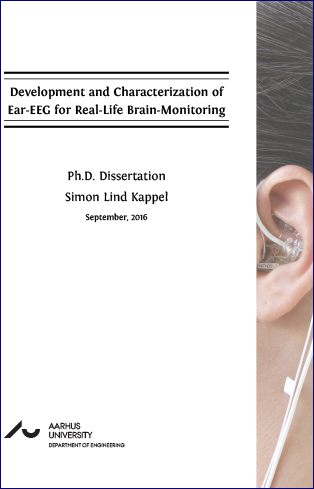Development and Characterization of Ear-EEG for Real-Life Brain-Monitoring
Nøgleord:
electroencephalography (EEG), ear-EEG, dry-contact biopotential electrode, wearable EEG, real-life, BCISynopsis
Functional brain monitoring methods for neuroscience and medical diagnostics have until recently been limited to laboratory settings. However, there is a great potential for studying the human brain in the everyday life, with measurements performed in more realistic real-life settings. Electroencephalography (EEG) can be measured in real-life using wearable EEG equipment. Current wearable EEG devices are typically based on scalp electrodes, causing the devices to be visible and often uncomfortable to wear for long-term recordings. Ear-EEG is a method where EEG is recorded from electrodes placed in the ear. The Ear-EEG supports non-invasive long-term recordings of EEG in real-life in a discreet way. This Ph.D. project concerns the characterization and development of ear-EEG for real-life brain-monitoring. This was addressed through characterization of physiological artifacts in real-life settings, development and characterization of dry-contact electrodes for real-life ear-EEG acquisition, measurements of ear-EEG in real-life, and development of a method for mapping cortical sources to the ear. Characterization of physiological artifacts showed a similar artifact level for recordings from ear electrodes and temporal lobe scalp electrodes. Dry-contact electrodes and flexible earpieces were developed to increase the comfort and user-friendliness of the ear-EEG. In addition, electronic instrumentation was developed to allow implementation in a hearing-aid-sized ear-EEG device. Ear-EEG measurements performed in real-life settings with the dry-contact electrodes, were comparable to temporal lobe scalp EEG, when referenced to a Cz scalp electrode. However, the recordings showed that further development of the earpieces and electrodes are needed to obtain a satisfying recording quality, when the reference is located close to or in the ear. Mapping of the electric fields from well-defined cortical sources to the ear, showed good agreement with previous ear-EEG studies and has the potential to provide valuable information for future development of the ear-EEG method. The Ph.D. project showed that ear-EEG measurements can be performed in real-life, with dry-contact electrodes. The brain processes studied, were established with comparable clarity on recordings from temporal lobe scalp and ear electrodes. With further development of the earpieces, electrodes, and electronic instrumentation, it appears to be realistic to implement ear-EEG into unobtrusive and user-friendly devices for monitoring of human brain processes in real-life.

